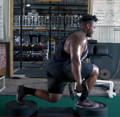How Do Football Lineman Train Legs?
One of the biggest failures that we see in strength training American Football linemen is when we watch athletes do quarter squats thinking it will help their line play or watching them perform power cleans where they starfish and almost blow out their back with their hips forward. The worst part of all is the way the movements are being executed leads to a lack of transfer to the field. Exercises need to be done properly to optimize transfer over to the field.

Now when we think about bigger athletes at the high-school level playing football, they tend to have struggles and problems performing movements through a full range of motion. They typically tend to be a little bit weaker deep in the hole. What does this mean for field play? It means we need to play with lower pads and a deeper hip level to dominate on the field. Lower pads on the field go a long way in owning the line of scrimmage.
4. Pause Back Squat
We already hear all the grumbling. All the football coaches, whistles in their mouths, and they have all their athletes doing low bar box squats to 90* with their knees never flexing. Nah. We want our linemen to go nice and deep. Start light and slowly build up the strength.
We want linemen to get nice and deep so they can improve their ankle mobility, hip mobility, knee flexion, lower back mobility, and dynamic trunk control. Athletes will squat nice and deep, pause for a solid count of One. Two. Go! Fast out of the hole!

Fast out of a very deep position will transfer well to a lineman in a three-point stance. A three-point stance requires a steep shin angle and dorsiflexion in the ankle. The nice and deep position in the squat transfers over to the field. Not only does it train mobility, but it increases strength and power dramatically from a deep position to keep the pads nice and low.
Do this movement twice a week. Go light one day and try to push the weight to increase strength on the other day. Perform three sets of four to five reps.
3. Sled Push Forward
We are looking at this movement from a unilateral perspective. This is a movement that a lot of football coaches utilize but we feel they don’t use it the right way. Like they just throw it in for conditioning and don’t use it to develop strength and power output.
Sled pushes help with unilateral cycling, running, and producing a ton of power. Think about it. Linemen have an opponent in front of them that they need to apply a ton of force in a unilateral position to manipulate the opponent. This is why we have to think of sled pushes being hit with nice and long arms while applying a lot of force through the lower body forward. This helps with running, pulling, and coming off the line.

We want to stay nice and deep during sled pushes. We want athletes to have a positive shin angle with hip extension. We also want to see an extension in the upper back so that the athlete is driving on the sled. Also, the sled can be really, really heavy because on the field the opponents on the line will be heavy as well (and pushing back).
We want to see a long drive that engages the quads and the glutes for strength work. We want to see plantar flexion with no heel dropping on the sled push. None at all! Keep the heel high. Knees forward with a forward chest lean that will help transfer to good speed, a good drive, faster off the ball, and good contact.
Athletes can perform two to three sets of five to ten-meter pushes of a heavy sled.
2. Elevated Split Squat
This movement gives us even more focus on unilateral work. We want to focus on hip mobility, hip flexion, and an upright trunk so that linemen don’t get dumped from leaning too much on the line of scrimmage. That is where the dumbbell split squat comes into play.
We prefer athletes do this from an elevated position so that a deeper position can be achieved. We want to hold dumbbells in a farmer’s carry, keeping the trunk upright and rigid with the back knee dropping to a pad between the two positions being held by the front foot and back foot. We want to get nice and mobile to open up the hips.

A lot of athletes, especially younger athletes, will struggle to do this movement. They will complain that their hip and quad are pulling. It may even pull on their knees a little bit because the athletes’ quads and hips are so tight. Hitting the nice and deep position will open up the hips and lengthen the quads. This will improve mobility and allow linemen to lower their pad level in a better position to compromise their opponents.
Do three sets of seven to nine reps on each leg. This will help with overall speed as well as improving overall structural integrity. Go into the movement slowly and add intensity over time.
1. Pause Below Knee Power Snatch
Let’s make linemen more athletic. Let’s help linemen learn how to recruit rapidly and absorb force quickly. This is why we want linemen to perform a power snatch or full snatch pausing below the knee.
Starting in a full snatch position off the floor because the hip angles, knee angles, and ankle angles in a three-point stance are almost identical to pulling off the floor. From there, athletes will pull about four to five inches, just below the knee, and pause for a slow three count. This will dramatically strengthen the posterior chain, lower back, and hips. Now as they come past the knee rapidly and make contact off the hip, they will utilize the upper body, turn the bar over, and catch with the chest coming forward.

Full cleans and full snatches need to be executed by every single lineman. It will teach lineman how to absorb energy in a deep position or power position.
Now the pause is similar to a hang but it strengthens the lower back even more. The key component to this movement though is teaching the body how to absorb the energy effectively. Absorbing energy to reuse it effectively is key in a contact sport like American football.
The goal is to eventually do full snatches. Start with powers. Then add in an overhead squat after catching the power. Once those skills are developed, it is just a matter of confidence and athleticism to drop into the hole.
Finally, the snatch develops great hip mobility, makes athletes incredibly rapid, and develops skills to make quicker contact on the field.
Do two to three sets of three to four sets.
Recap
All four of these lower body strength exercises are great for linemen. The movements not only develop strength through full ranges of motion, but they also create the capability for athletes to be more mobile, explosive, and rapid in their movement. Better still, the variation in the movements trains bilateral and unilateral strength and puts demands on improving athleticism while teaching the body to engage strength in multiple positions. Best of all, the movements transfer over to the field for heightened play. Give the exercises a try and let us know how much quicker that first step before contact becomes.
DANE MILLER
Dane Miller is the owner and founder of Garage Strength Sports Performance. He works with a select handful of clients on building comprehensive programs for fitness and nutrition. Several times a year he leads a workshop for coaches, trainers, and fitness enthusiasts.


